The beauty industry in 2025 is booming like never before – with global revenue projected to reach $600 billion. This growth is fueled by consumers seeking niche, authentic brands that align with their values. Unlike mass-market giants, independent beauty brands can tell unique stories and cater to specific needs (think cruelty-free skincare or gender-inclusive cosmetics). White label dropshipping makes this possible by allowing entrepreneurs to sell high-quality cosmetics and skincare under their own brand name, without investing in product development or inventory. It’s an ideal path for both beginner beauty entrepreneurs and experienced dropshippers in the U.S. market to launch a line quickly and with minimal overhead.
Why focus on white label beauty products? Simply put, customers are buying more than just lotion or lipstick – they’re buying into a brand identity. In 2025, shoppers crave products that reflect personal values (organic ingredients, eco-friendly packaging, etc.), and they love discovering boutique brands on social media. White label dropshipping lets you tap into these trends by rebranding proven products and customizing packaging to stand out. Modern suppliers (like CJdropshipping, Blanka, or Spocket) even offer print-on-demand labeling and fast U.S. shipping to help new beauty brands hit the ground running.
In this comprehensive guide, we’ll explore the top 15 white label beauty product niches for 2025. For each niche, you’ll find a concise description, examples of popular products, the ideal customer profile, and practical dropshipping tips on sourcing, branding, pricing, and marketing. Whether you’re passionate about skincare or eager to ride the next makeup trend, these niches can spark ideas for your own branded beauty line. Let’s dive in!
1. Skincare Essentials - White Label Beauty Dropshipping Products
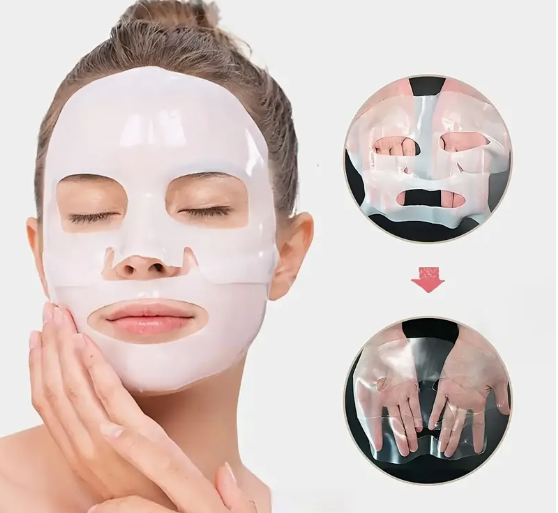
Niche Description: Skincare remains the cornerstone of the beauty market. Everyday essentials like cleansers, serums, and moisturizers are consistently in demand across all age groups. Products such as hyaluronic acid serums and vitamin C creams are trending due to their visible results and broad appeal. Importantly, skincare encourages recurring purchases – once customers find a product that works, they tend to reorder regularly. This means a skincare brand can build strong customer lifetime value through loyalty and subscription sales.
Popular Product Types: Gentle facial cleansers, hydrating serums (e.g. hyaluronic acid), anti-blemish toners, daily moisturizers with SPF. For example, vitamin C serums and niacinamide creams are hot sellers in 2025.
Ideal Customer Profile: Skincare enthusiasts of all genders, typically young adults to middle-aged consumers (20s–40s) who prioritize daily self-care. They are ingredient-savvy, looking for effective formulas that address concerns like dryness, acne, or aging. Many value clean, fragrance-free products suitable for sensitive skin.
Dropshipping Tips:
-
Source Quality & Transparency: Partner with suppliers that provide detailed ingredient lists and quality certifications (e.g. FDA or GMP) – skincare buyers are very ingredient-conscious. Consider suppliers like SelfNamed or Spocket that offer clean-label or natural skincare lines for white labeling. Always order samples to test product texture and efficacy before adding to your store.
-
Branding & Packaging: Emphasize a professional, trustworthy image. Use minimalist packaging with your logo and highlight key ingredients on the label (for example, “with Organic Aloe & Vitamin C”). Skincare branding should convey safety and results. Offering sample kits or travel sizes can be a great marketing tactic to hook new customers into your skincare line.
-
Marketing Strategies: Leverage content marketing and education – publish skincare tips, routines, and before-and-after results. Platforms like Instagram and TikTok are excellent for showcasing product application and glowing reviews. Encourage user-generated content (like “shelfies” of customers’ skincare shelf) to build social proof. Also, consider a subscription model (monthly skin care boxes) to increase retention, as skincare is a routine-based niche.
2. Lip Products - White Label Beauty Dropshipping Products
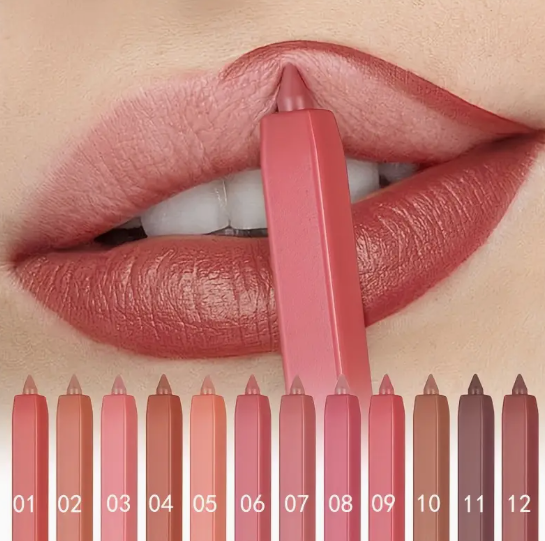
Niche Description: Lip products are a small but mighty niche in beauty. From moisturizing balms to glossy lip tints, these items are makeup staples that also tap into skincare (hydration) benefits. In 2025, lip products are frequently going viral on social media – thanks to TikTok tutorials and the “no-makeup makeup” trend favoring natural, glossy lips. They’re typically low-cost items with high markup potential, and their compact size makes them ideal for bundling or impulse buys.
Popular Product Types: Tinted lip balms, lip glosses with a sheer shine, matte liquid lipsticks, and lip plumping serums. For example, sheer moisturizing balms and fruity glosses are especially popular in the current “clean girl” aesthetic trend.
Ideal Customer Profile: Primarily Gen Z and Millennial females (teens to 30s) who follow beauty influencers and viral trends. They often prefer products with natural ingredients (like shea butter or jojoba oil) to keep lips nourished. The ideal customer loves experimenting with new colors but also wants everyday hydration – meaning they might buy multiple flavors or shades if the price is right.
Dropshipping Tips:
-
Sourcing & Customization: Look for suppliers that allow customization of shades and flavors. A platform like CJdropshipping or Blanka can source a variety of lip product formulas with your branding. Ensure the products are cruelty-free and use quality ingredients, as this is a selling point (e.g., vegan, paraben-free lip balms appeal to conscious consumers).
-
Branding & Packaging: Lip products are perfect for creative branding – think cute, pocket-sized containers or tubes with your logo. Consider offering sets (e.g., a trio of different tinted balms) in custom packaging. Fun, colorful branding can attract younger audiences. Make sure to highlight any unique value (such as “made with organic beeswax” or “long-lasting 8-hour wear”) on the packaging and product page.
-
Marketing & Pricing: These items have impulse-buy appeal, so keep pricing accessible – for instance, a $5-$15 range for balms and glosses. Use social media marketing heavily: short video swatches, “lip of the day” posts, and influencer shout-outs can drive sales. Since lip products are visually appealing, platforms like Instagram, TikTok, and Pinterest work well. You might even collaborate with micro-influencers for discount codes or bundle deals (e.g., buy two, get one free) to encourage multi-item purchases.
3. Eye & Brow Products - White Label Beauty Dropshipping Products
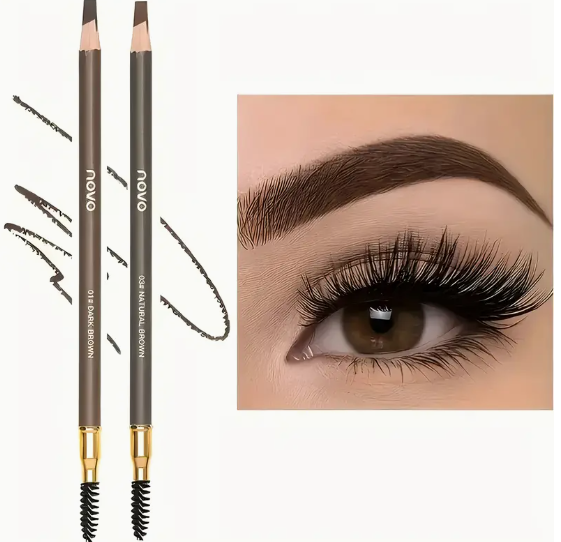
Niche Description: Eye makeup and brow grooming products form a thriving niche, as well-defined eyes and brows remain central to beauty routines. In 2025, consumers – especially Gen Z – gravitate toward products that enhance natural beauty subtly: think lengthening mascaras, smudge-proof eyeliners, and brow gels for fluffy, full brows. With video tutorials and selfies focusing on eye looks, these products get a lot of social media love. They’re small, easy to ship, and often have strong repeat-buy potential (mascara, for example, is replaced every few months).
Popular Product Types: Mascara (lengthening, volumizing, waterproof variants), eyebrow pomade or gels, liquid or pen eyeliners, and eyebrow grooming kits. Brow shaping kits and lash growth serums are also trending as people aim for naturally fuller brows and lashes.
Ideal Customer Profile: Makeup enthusiasts across a wide age range, but especially Gen Z and Millennial women (late teens to 30s). They may be beginners experimenting with looks or beauty aficionados who follow the latest brow trends. This customer values products that are easy to use and long-lasting – for instance, a mascara that won’t flake during the day or an eyeliner that stays put. Many also seek out waterproof or smudge-resistant formulas for all-day wear.
Dropshipping Tips:
-
Product Quality Matters: Eyes are sensitive, so quality is paramount. Choose suppliers known for good formulations (check reviews or supplier descriptions for things like “ophthalmologist-tested” mascaras or non-irritating ingredients). It can be worth sourcing from specialized private label makeup suppliers like Blanka (known for North American-made cosmetics) or viaGlamour for cruelty-free options.
-
Diverse Offerings: Stock a range of shades (e.g., black and brown mascaras, various brow colors to match hair) to widen your market. Ensure your eyebrow products come in multiple tones for different hair colors. You can also offer bundle deals, such as an “Eye Essentials Kit” with an eyeliner, mascara, and brow gel together – boosting average order value.
-
Marketing & Influencers: Eye and brow products thrive on visual demonstration. Encourage customers or influencers to post before-and-after transformations using your products. Quick tutorials (like “60-second smokey eye” or “how to use brow soap”) make great content. Use hashtags and engage with beauty communities on YouTube or TikTok. When setting pricing, note that these products often have great margins – for example, a mascara might cost $3-$5 from a supplier and sell for $15-$20. Emphasize the benefits (length, waterproof, vegan, etc.) in your product copy to justify the pricing. Also, consider seasonal marketing – e.g., promoting bold eye looks for holiday seasons or shimmering eyeliners during festival times.
4. Face Makeup-White Label Dropshipping Products (Foundations, BB Creams, etc.)

Niche Description: Face makeup includes foundation, concealers, BB/CC creams, blushes, and highlighters – everything that creates a flawless base. In 2025, there’s a big movement toward “skinimalism,” where consumers prefer lighter coverage and multi-functional products that blend skincare and makeup. For example, tinted moisturizers or BB creams with SPF and hydrating ingredients are on the rise, as they offer a natural look while providing skin benefits. This niche has strong demand but also requires careful attention to diversity (shades) and formulation (people have varying skin types).
Popular Product Types: Liquid foundations (ideally buildable or lightweight formulas), BB or CC creams, concealer sticks, and cream blush/highlighter that give a dewy look. Products that combine skincare – like a foundation infused with hyaluronic acid or a primer with sunscreen – are especially popular for their dual benefits.
Ideal Customer Profile: Adults from their 20s to 40s who use daily face makeup. This includes everyday makeup wearers seeking a quick, natural routine (busy professionals or students) as well as makeup lovers who enjoy full-glam looks on occasion. Many are seeking products that feel breathable on the skin and enhance natural glow rather than heavy matte looks. Inclusivity is key – customers span multiple skin tones and may prefer brands that cater to a wide range of shades for foundations.
Dropshipping Tips:
-
Shade Range & Inclusivity: Work with suppliers that offer a broad shade range for foundations and concealers. Nothing will sink a face makeup brand faster than excluding skin tones. Check if your supplier (e.g., Blanka or Jubilee) provides at least 10-15 foundation shades or the option to create custom shades. It’s a selling point to advertise “inclusive shade range” on your site. You can start with a focused range and expand based on demand, but always cover light, medium, and deep categories.
-
Private Label Packaging: Face products often come in bottles, tubes, or compacts that are perfect for branding. Use a sleek design with your logo – for instance, a frosted glass bottle with a pump for foundation gives a high-end feel. Make sure to include usage instructions on the label (e.g., “shake well” or “SPF 30” if applicable). If your supplier offers custom packaging (many do for white label), invest in a quality foundation bottle or palette that gives a professional impression.
-
Marketing & Education: Selling foundation online can be tricky due to shade matching. Mitigate this by providing a shade finder guide on your store: describe each shade’s undertone and compare to popular brands (“if you wear MAC NW20, try our Shade 2”). Encourage customers to post selfies wearing your products (user reviews with photos build trust). For marketing, emphasize the dual benefits like “hydrating glow” or “2-in-1 skincare + foundation” to tap into the skinimalism trend. Video content demonstrating before/after coverage or all-day wear tests can attract viewers. Lastly, consider offering a flexible return or exchange policy for first-time foundation purchases – it reduces the risk for customers trying your brand.
5. Haircare Products - White Label Beauty Dropshipping Products

Niche Description: Haircare is experiencing a renaissance in 2025, with consumers treating it as an extension of beauty and wellness. This niche covers shampoos, conditioners, hair serums, oils, and treatments. A big trend is “scalp care,” focusing on scalp health as the foundation for great hair. Natural oils (like rosemary or argan oil) for scalp massages and sulfate-free, paraben-free formulations are in high demand. Additionally, the rise of hair growth serums and biotin-infused products indicates people are investing in products that promise thicker, healthier hair. Haircare has become a self-care ritual, attracting loyal repeat buyers who stick to regimens that work.
Popular Product Types: Sulfate-free shampoos and conditioners, hair growth & thickening serums, anti-frizz hair oils, leave-in conditioners, and scalp scrubs or treatments (for issues like dandruff or scalp hydration). For example, rosemary oil scalp treatments are trending after going viral for their hair growth benefits. Also, shampoo bars (solid form) appeal to eco-conscious consumers looking to cut down plastic.
Ideal Customer Profile: Men and women from late 20s to 50s who are focused on hair health. This includes individuals dealing with specific concerns (hair thinning, dry scalp, color-treated hair care) and those embracing natural, toxin-free haircare. Many are willing to pay a premium for salon-quality results at home. An ideal customer might be a health-conscious person who reads ingredients, or someone with a specific hair texture (curly hair, for instance) seeking products tailored to them.
Dropshipping Tips:
-
Sourcing & Formulations: Partner with suppliers that emphasize quality ingredients. Look for labels like “paraben-free, SLS-free, vegan” on shampoos, as these buzzwords attract buyers. Some dropshipping suppliers specialize in natural haircare – for instance, viaGlamour (for vegan formulations) or Supliful for supplement-infused hair wellness products. If possible, source a mix of products that address different needs (e.g., one line for dry hair with coconut oil, another for oily scalp with tea tree). This allows you to target sub-groups in your marketing.
-
Bundles and Kits: Haircare is perfect for bundling. Offer sets like a “Hydration trio” (shampoo, conditioner, hair mask) or a “Scalp Care Kit” with scrub, serum, and massager tool. Bundles not only increase average order value but also provide a convenient regimen for customers. Ensure consistent branding across the kit – maybe a themed box or a pamphlet with tips on how to use the products together.
-
Marketing & Brand Voice: Position your brand as a haircare expert. Share tips via a blog or social posts (e.g., “5 tips for a healthier scalp” or “How to manage curly hair frizz”). Tutorial videos showing proper application (like how to do a scalp massage with your oil) can establish authority. For marketing channels, Instagram and YouTube are powerful – think before-and-after testimonial videos or influencer reviews demonstrating results after 1 month of using your hair serum. Encourage customers to share their “hair journey” with your products for social proof. Lastly, highlight any special ingredients (biotin, keratin, argan oil) in your copy – these keywords are often searched by those looking for hair solutions.
6. Men’s Grooming Products - White Label Beauty Dropshipping Products

Niche Description: The men’s grooming niche has exploded from a small specialty segment into a mainstream market. Modern men are investing in skincare, beard care, and personal grooming more than ever before. This niche includes products like beard oils, shaving creams, face wash, moisturizers, and even subtle makeup or concealer for men. The trend is driven by a cultural shift – male influencers and celebrities openly discuss grooming routines, making it more socially normal for men to care about these products. As a result, demand for high-quality, male-focused products (often with masculine branding and scents) is surging.
Popular Product Types: Beard oil and beard balms, shaving kits (razor, natural shaving soap, aftershave lotion), mattifying face moisturizers (to reduce shine), anti-aging creams for men, and 2-in-1 shower products (like all-in-one body and hair wash). Beard grooming kits are especially popular – for example, a kit might include beard oil, beard shampoo, a comb, and scissors. Also, men’s skincare sets (cleanser, toner, lotion) targeted at simple daily routines.
Ideal Customer Profile: Primarily male customers aged 20-45. There are a few sub-groups: young professionals in their 20s and 30s who want to maintain a polished appearance (perhaps dealing with acne or wanting to prevent aging), and older men (40s) interested in anti-aging and keeping a youthful look. Many are beginners to grooming, so they prefer straightforward products (e.g., a one-step face wash) and minimalistic branding. They are attracted to a more masculine or neutral presentation – think sleek black or navy packaging, subtle masculine scents like sandalwood or cedar.
Dropshipping Tips:
-
Product Sourcing: Choose suppliers that understand men’s formulations – for instance, beard oils that use natural carrier oils (jojoba, argan) and masculine scents, or face creams that are light and non-greasy. Suppliers like CJdropshipping and AliExpress have entire categories for men’s grooming; additionally, some private label lines (like Jubilee or Brooklyn Botany style brands) cater to men’s products. Look for those offering private label on things like beard oil, as branding is key.
-
Brand Identity: Men’s grooming brands should project simplicity and quality. Use a minimalist logo and packaging – often just your brand name in a clean font on a solid-color background works well. Include usage instructions clearly, since some men may be new to the product (e.g., how to use beard oil and how often). If possible, differentiate with something like a signature scent or a unique hero ingredient (e.g., “with sandalwood oil” or “vitamin C enriched”).
-
Marketing Approaches: To reach male audiences, consider platforms like YouTube (for how-to content) and Instagram, as well as targeting through Facebook Ads by interests (e.g., men’s fashion, gym, business professionals). Content ideas include grooming tutorials (“How to shape your beard at home”) or skincare basics for men. Influencer marketing can work here: collaborate with male lifestyle bloggers or barbershop owners who can endorse your products. Keep marketing language direct and solution-oriented – for example, “Reduce beard itch and promote healthy growth” or “Oil-free lotion for shine control.” When pricing, note that men’s products often sell at a slight premium if positioned as specialty (e.g., beard oil at $20+ for a small bottle is common), so ensure your perceived value (quality ingredients, nice packaging) matches the price.
7. Eco-Friendly & Sustainable Beauty - White Label Beauty Dropshipping Products
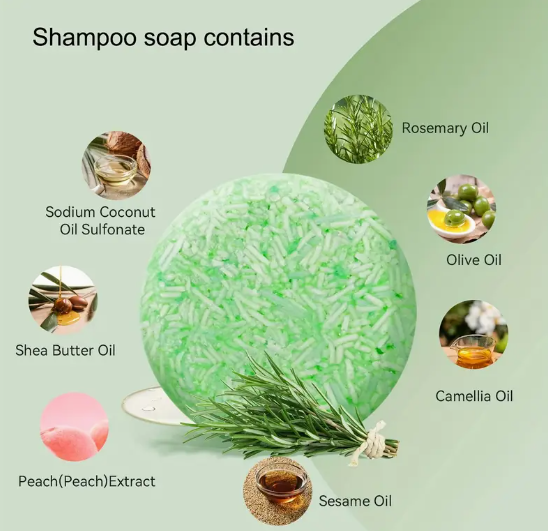
Niche Description: Sustainability isn’t just a buzzword – it’s a major driving force in beauty purchases for 2025. The eco-friendly beauty niche focuses on products and brands that minimize environmental impact. This includes items with refillable or recyclable packaging, vegan ingredients, cruelty-free certification, and zero-waste products (like shampoo bars or reusable makeup removers). Consumers, especially younger ones, now expect brands to have green values – vegan, cruelty-free, and sustainable packaging are often standard requirements, not just perks. This niche overlaps with many product categories (skincare, haircare, etc.) but stands out by its ethos and materials.
Popular Product Types: Refillable makeup palettes (where consumers can buy refills instead of a whole new compact), bamboo makeup brushes and accessories, shampoo and conditioner bars (plastic-free), deodorants in biodegradable tubes, and skincare packaged in glass jars or recyclable tins. Cruelty-free vegan cosmetics (no animal testing or animal ingredients) are also key here – e.g., vegan lipstick or plant-based skincare. Additionally, products that come with minimal packaging or are waterless formulations (like powder cleansers you mix with water at home) are gaining traction for reducing shipping weight and packaging waste.
Ideal Customer Profile: Largely Gen Z and Millennial consumers (age 18-40) who are eco-conscious and willing to support brands that align with their environmental and ethical values. They often live in urban areas or college towns, follow sustainability influencers, and may be willing to pay a bit more for products that are green. This customer reads labels for things like “100% vegan” or “cruelty-free bunny logo.” They also appreciate transparency – brands that share their sourcing or charitable initiatives resonate well.
Dropshipping Tips:
-
Certifications & Trust: When sourcing, seek suppliers that can provide proof of claims – for example, cruelty-free certification (Leaping Bunny) or organic ingredient certifications. Being able to mention these on your site builds trust. If a supplier like SelfNamed or viaGlamour offers vegan, natural formulations with documentation, that’s a big plus. Also, look for product listings that mention “eco-friendly packaging” or compostable materials to ensure you’re delivering the sustainability you promise.
-
Packaging and Product Design: For a sustainable brand, packaging is part of the product. Opt for packaging options like recyclable glass, aluminum tins, or PCR (post-consumer recycled) plastic if available. Some dropshipping suppliers offer custom packaging upgrades – for instance, MagicSoaps ships in custom eco-friendly boxes for their private label soaps. Even if you can’t custom-design everything, you can include a note in each order about recycling the package or offer a mail-back program for empties (if feasible). Small touches like kraft paper labels or a minimalist green leaf design in your logo can visually communicate your eco stance.
-
Marketing & Community: Storytelling is powerful here. Share your brand’s mission (“beauty without harm” etc.) on your About page and product descriptions. Use content marketing to discuss topics like sustainable living, zero-waste beauty routines, or how your brand reduces its carbon footprint. Social media strategy should include showcasing your products in nature settings or reposting user-generated content from eco-conscious customers. Partner with eco influencers or participate in “plastic-free July” challenges online to get visibility. Also, highlight any philanthropy (for example, “$1 from each sale goes to ocean cleanup”) to further appeal to values-driven shoppers. SEO tip: include keywords like “zero-waste beauty,” “vegan skincare,” and “sustainable cosmetics” on your site for discoverability, as search volume for these terms is high and growing.
8. Organic & Natural Skincare - White Label Beauty Dropshipping Products
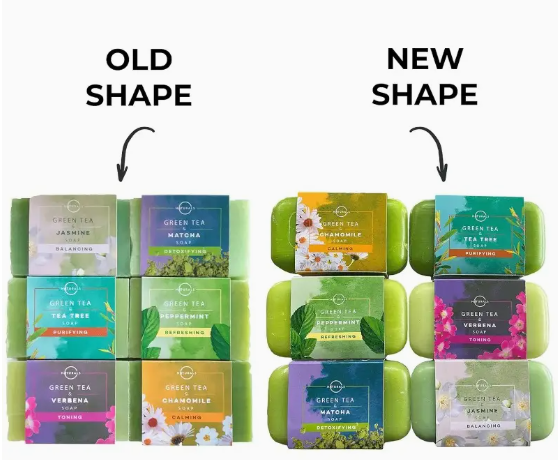
Niche Description: The organic beauty niche focuses on products made from natural, plant-based ingredients with minimal to no synthetic chemicals. These are products often labeled “organic,” “100% natural,” “non-toxic,” or “free from parabens/sulfates.” In an era where consumers are extremely aware of what they put on their skin, this niche is booming. Many people are actively seeking out skincare that is as clean and green as possible. The market for organic beauty is not only large but also growing rapidly, with consumers willing to pay more for these products due to health and environmental concerns.
Popular Product Types: Organic face oils (like rosehip or argan oil serums), natural soaps and body lotions (scented with essential oils instead of synthetic fragrance), aloe vera gels, clay masks, and herbal creams (e.g., calendula cream for sensitive skin). Solid shampoo bars and mineral-based sunscreens also fall in this niche as they avoid harsh chemicals. Additionally, products emphasizing a single powerful natural ingredient – like a turmeric face mask or green tea cleansing balm – are popular for storytelling and marketing.
Ideal Customer Profile: Typically female consumers aged 25-45, often health-conscious or those with sensitive skin who believe “natural is better” for their skin. This includes new moms seeking gentle products, individuals with allergies looking to avoid artificial additives, or generally anyone aligned with the organic lifestyle (they might also buy organic food, etc.). They are label-readers: if an ingredient list is short and recognizable (think “shea butter, coconut oil, lavender extract”), they feel more confident. They also appreciate eco-friendly practices, but their top priority is personal health and gentleness of the product.
Dropshipping Tips:
-
Supplier Selection: Not all “natural” claims are equal – partner with reputable suppliers that truly specialize in natural formulations. For example, some suppliers on Spocket offer artisan-made organic skincare from U.S. or EU producers. Look for keywords like “USDA Organic” or “Made with organic ingredients” in product descriptions, or consider working with private label companies that focus exclusively on natural cosmetics. Always sample these products yourself; natural products can have shorter shelf lives, so ensure what you sell is fresh (in dropshipping, this is usually fine as products are made on demand or in small batches).
-
Brand Story & Transparency: Use storytelling to your advantage. Share on your site why natural ingredients matter – e.g., “Our products are free from parabens, phthalates, and artificial fragrances.” You could even have a webpage or infographic explaining the benefits of your key ingredients (“Rosehip Oil – rich in Vitamin C for glowing skin,” etc.). Emphasize any certifications (like cruelty-free or organic certifications) – for instance, “Certified organic ingredients” can be highlighted if applicable. Being transparent about sourcing (e.g., “our shea butter is fair-trade from Ghana”) can set you apart and build trust with your audience.
-
Pricing & Marketing: Organic and natural products often command higher prices due to premium ingredients – don’t be afraid to set a slightly premium price point, justified by quality. Many consumers will pay $25 for an organic face serum that they perceive as cleaner/safer versus $10 for a conventional one. Market your products through channels like health and wellness blogs, Instagram pages focusing on clean beauty, and even Pinterest (a lot of people search for DIY and natural beauty tips there). SEO strategy: incorporate terms like “natural skincare for sensitive skin” or “organic beauty products USA” which reflect what your target might search. Also, content marketing can include tips like “5 Benefits of Switching to Natural Skincare” – drawing in readers who could convert to customers. Remember, the organic niche isn’t just selling a product, it’s selling a lifestyle and peace of mind.
9. Vegan & Cruelty-Free Cosmetics - White Label Beauty Dropshipping Products
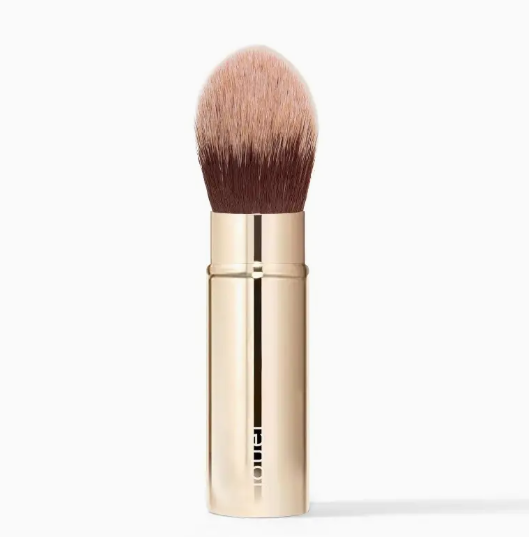
Niche Description: Vegan and cruelty-free beauty has shifted from niche to mainstream as consumers rally against animal testing and animal-derived ingredients. This niche encompasses makeup and skincare products made without animal ingredients (vegan) and not tested on animals (cruelty-free). In 2025, the vegan cosmetics market is experiencing strong growth, fueled by rising awareness of animal welfare and a general demand for ethical products. Importantly, many vegan products also overlap with clean beauty since they often use plant-based ingredients instead of things like beeswax or carmine. This niche appeals not only to vegans but to a broad segment that values ethical consumerism.
Popular Product Types: Vegan makeup – for example, lipsticks made with plant oils instead of beeswax, foundations without animal-derived glycerin, or makeup brushes made with synthetic bristles instead of animal hair. Also, skincare like moisturizers and serums that use plant substitutes for things like collagen (e.g., seaweed collagen). Cruelty-free has become common even in mascara and skincare – meaning the brand does not test on animals at any stage. Specific hot items include vegan eyeshadow palettes (often highlighting botanical ingredients, mineral pigments), and cruelty-free nail polishes. Even false eyelashes now have vegan versions (not made from mink fur, but synthetic silk).
Ideal Customer Profile: Conscious consumers across various ages, primarily Millennials and Gen Z (18-40) who actively seek out products aligned with their values. This includes dedicated vegans/vegetarians, as well as people who simply prefer ethical choices when available. They often cross-shop in organic/natural niches too, but the primary driver here is “no harm to animals.” They might check for the Leaping Bunny or PETA-certified logos on products. Many are also into indie brands – they love discovering and supporting companies that share their ethos.
Dropshipping Tips:
-
Find the Right Suppliers: Seek out suppliers or manufacturers that explicitly market their products as vegan and cruelty-free. For example, viaGlamour in Canada offers a catalog of 800+ private label cosmetics that are all cruelty-free and have zero order minimums – a great option for starting out. Similarly, some suppliers on platforms like Alibaba/AliExpress will label items as vegan (but double-check credibility). Ensure any product you list has no animal derivatives (common hidden ones: lanolin, carmine, beeswax, keratin). It’s worth curating a smaller selection that you are confident about, rather than a huge catalog that might have non-vegan surprises.
-
Communicate Ethics Clearly: Make “Vegan & Cruelty-Free” a prominent part of your branding. Badges or icons on each product page (e.g., a vegan leaf icon, a bunny icon for cruelty-free) can instantly assure customers. Include a FAQ on your site about what those terms mean for your brand (some customers might not know the difference between vegan and cruelty-free – you can educate them that vegan refers to ingredients, cruelty-free to testing). Storytelling can include why you chose to go vegan beauty – e.g., “After learning that many cosmetics still use animal by-products, we set out to create a line that’s 100% plant-powered and ethically made.”
-
Community & Marketing: The vegan beauty community is passionate and vocal. Engage with them on social media – use hashtags like #veganbeauty and #crueltyfree which are popular. Consider partnering with vegan lifestyle influencers or cruelty-free beauty bloggers for reviews. If there are subscription boxes or blogs focused on cruelty-free products, get your brand featured. Also, leverage user reviews: encourage customers to leave testimonials highlighting how happy they are to find effective products that align with their values. For marketing content, focus on both ethics and performance (some consumers still have a misconception that vegan products might not work as well – show that yours are high-quality). For example, do side-by-side makeup looks showing pigment or longevity of your vegan makeup. Pricing can be mid-range; many people expect to pay a small premium for ethical products, but with white label dropshipping you can often price competitively since supplier costs are similar to non-vegan options. Use that as an advantage to make ethical beauty accessible.
10. Bath & Body - White Label Beauty Dropshipping Products
(Soaps & Personal Care)

Niche Description: The bath and body niche is all about everyday personal care with a touch of indulgence. This includes items like body washes, artisan soaps, bath bombs, body scrubs, and lotions. In 2025, self-care rituals are a huge trend – people are turning their bathrooms into mini home spas. That means demand for luxurious, spa-like bath products (e.g. aromatic bath bombs, lavender-scented soap bars, sugar scrubs) has climbed. This niche also overlaps with gifting (think of all the bath gift sets on the market). Many dropshippers have found success selling beautifully packaged soap sets or bath bomb kits, especially when you can brand them as your own.
Popular Product Types: Handmade or natural soap bars (with ingredients like goat’s milk, charcoal, or essential oils), bath bombs in various scents and colors, exfoliating body scrubs (coffee scrub, himalayan salt scrub), and rich body butters/lotions. Shower steamers (like bath bombs but for the shower) are an emerging product too. Additionally, products like bath salts with aromatherapy benefits (e.g., Epsom salt with eucalyptus) are popular for relaxation.
Ideal Customer Profile: Women aged 18-45 are a primary market, especially those into self-care routines. Also busy professionals or moms who crave a little “me time” in a hot bath. However, men are also a growing segment (some prefer gender-neutral or woodsy scents). Many customers in this niche appreciate artisanal vibes – they like products that feel handcrafted or special as opposed to generic store brands. These customers often shop for themselves but also for gifts (birthdays, Mother’s Day, holidays – bath sets are common gifts), so presentation is key.
Dropshipping Tips:
-
Private Label Suppliers: If you can find a specialty supplier for these items, that’s gold. For example, MagicSoaps is a dropshipping supplier focused on private label soap bars made in Canada, offering eco-friendly packaging and custom branding. Such suppliers handle small-batch, quality products which you can brand with your own label. Using them means you can market your line as “handcrafted” or “luxury” bath items. Ensure any bath bomb or cosmetic is compliant with regulations (in the U.S., that usually means ingredient labels are needed, etc., but most established suppliers will handle that).
-
Branding & Packaging: Visual appeal is everything in this niche. Bath products should look and feel gift-worthy. Work on elegant or fun packaging – for instance, soaps wrapped in custom paper with your logo, or bath bombs in a box with crinkle paper and a branded sticker. If custom packaging through the supplier is not an option initially, you can still design beautiful labels to be affixed. Highlight the scents and ingredients on the packaging (“Lavender Vanilla Relaxation Bath Bomb” for example) – these sensory words help sell the experience.
-
Store Presentation & Marketing: High-quality product photos are a must. Use imagery of fluffy bubbles, colorful bath water, or close-ups of the texture of a sugar scrub to tantalize shoppers. Consider Instagram and Pinterest for marketing since this niche is very visual; share posts about “unwinding after a long day” with your products featured. You can also market seasonally – e.g., pumpkin spice scented soaps in autumn, peppermint bath bombs at Christmas, etc. Offer bundles or sets (like a trio of bath bombs, or a spa basket with multiple items) to increase the cart value. And encourage reviews that mention the experience, e.g., “The bathroom smelled like a spa!” – these qualitative aspects can sway new customers. Price-wise, artisan bath products can be priced at a premium ($8-10 per soap bar, $5-7 per bath bomb, etc.), especially if you emphasize the handmade or natural aspect. People expect to pay for the pampering experience.
11. Perfumes & Fragrances - White Label Beauty Dropshipping Products

Niche Description: Fragrances – including perfumes, colognes, and essential oil blends – represent a classic yet interesting niche for dropshippers. Traditionally, perfumes are dominated by big brands, but there’s room for white label fragrances if done right (e.g., offering signature scents under your own brand). Some entrepreneurs formulate unique scents via private label manufacturers. Alternatively, dropshipping existing perfume brands is an option (though that’s not white label, it can be a related strategy – suppliers like FragranceNet specialize in dropshipping brand-name perfumes). In 2025, consumers enjoy having a “signature scent” and many are open to indie perfume brands that offer quality at a better price. Also, home fragrances (like candles or diffusers) could fall into this category as a related niche expansion.
Popular Product Types: Eau de parfum or eau de toilette sprays for men and women, perfume oil rollers, and scented body mists. Also, unisex fragrances are on trend – scents that aren’t labeled for a specific gender. In terms of notes, niche customers might seek out perfumes with natural or exotic ingredients (jasmine, oud, sandalwood) to differentiate from generic mall scents. Essential oil blends that work as natural perfumes (for example, a lavender-vanilla calming roll-on) are popular for those wanting a more holistic vibe. Additionally, perfume sampler sets (small vials of multiple scents) can be a hit, allowing customers to try out and find their favorite.
Ideal Customer Profile: Adults 25-50 who enjoy fragrances. This niche can attract two types: budget-conscious shoppers looking for an affordable alternative to luxury perfumes, and fragrance enthusiasts who love discovering new scents (the kind who might normally browse Sephora for indie perfumes). Men and women both buy perfumes; men’s colognes are a solid sub-niche, often purchased as gifts as well. Customers might have preferences like floral vs. woody vs. fresh scents, so offering variety is key. If you go the essential oil route, expect interest from the wellness crowd as well (overlap with people who like aromatherapy).
Dropshipping Tips:
-
White Label Perfume Creation: If you want truly white label perfumes, look into suppliers or manufacturers that do custom fragrance oils. Some companies will let you choose from stock scents or even help create a unique blend, then package it under your brand. Minimum order quantities can sometimes be higher in perfumes, but there are dropship-friendly ones too. For instance, some European suppliers might offer a line of generic fragrances similar to popular scents that you can brand (check directories or supplier lists for private label perfume options). Make sure any fragrance supplier complies with shipping regulations (perfumes are alcohol-based and considered hazardous for air shipping – but many have solutions for that, especially if they stock in the US for domestic orders).
-
Branding & Presentation: Perfume is all about image and story. Develop a brand story for your fragrance line – perhaps it’s inspired by travel (scents of different locales) or by moods (a scent for romance, one for energy, etc.). Each scent should have a creative name and a description of its notes (“Top notes of citrus, heart of rose, base of amber…”). Invest in designing an elegant logo and label for the bottles. A 50ml glass bottle with a nice cap can be made to look very high-end with the right label. If possible, get custom boxes for each bottle as well – perceived value is important for fragrance.
-
Marketing & Selling: Since customers can’t smell through the screen, use evocative language and imagery. High-quality photos of the bottles are a must, and you can also use images that represent the scent (like a field of lavender for a lavender scent). Offering a sample set is a clever way to get customers in – they buy a sampler, then come back to purchase full sizes of the ones they love. Encourage reviews where customers describe the scent in their own words (“smells like a fresh spring morning” etc.). You might also include a scented insert in orders (if fulfilling through a supplier that allows adding a card) to delight them. Leverage social media by educating people (“How to make your perfume last longer on the skin” or “Perfume layering tips”). Keep in mind, perfumes often have high markup potential – a bottle that costs $5-$10 from a supplier could retail for $30-$60 depending on branding. If you also dropship brand-name perfumes (via a supplier like FragranceNet), you can use those to draw traffic, but your own branded line can be the hero product with better margins.
12. Nail Care & Art Products - White Label Beauty Dropshipping Products
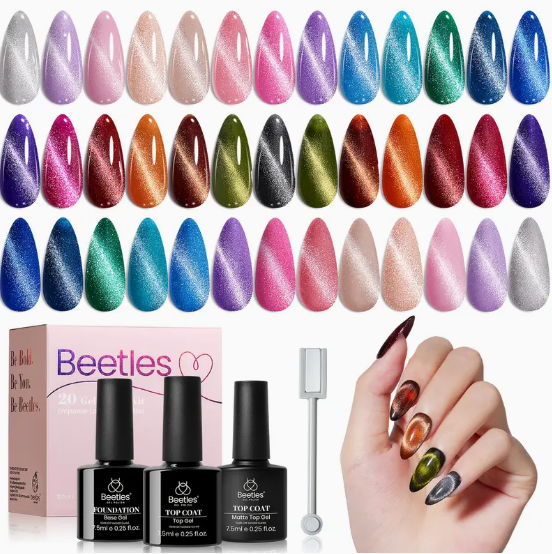
Niche Description: The nail care niche includes everything from nail polishes and gels to manicure tools and nail art accessories. It’s a vibrant market driven by trends in DIY manicures and creative nail art designs. With more people doing their nails at home (especially after recent years of salon closures and the rise of at-home beauty content), demand for nail supplies online is surging in 2025. This niche is quite broad: you can focus on natural/healthy nail products (like non-toxic polishes), trendy nail art (stickers, jewels, press-on nails), or professional-grade tools (UV lamps for gel nails, electric nail drills). The key is that it’s a visually driven, fashion-influenced niche with frequent product newness (new colors, seasonal designs, etc.).
Popular Product Types: Press-on nails have become extremely popular – they offer salon-like art without the cost and can be changed frequently. There are many designs and they’re great for dropshipping since sizing is usually standard. Also, gel nail polish kits (UV/LED lamp plus gel polish sets) are big sellers for those who want long-lasting manicures at home. Classic nail polishes (especially those that are 5-free or 7-free, meaning free of certain chemicals) cater to the health-conscious segment. Nail art decorations like stickers, foils, and rhinestones are cheap and cheerful add-ons. Don’t forget basic manicure tools: files, buffers, cuticle oil, etc., often sold in kits.
Ideal Customer Profile: Predominantly female consumers, teens to 30s, who enjoy personalizing their look. Gen Z, in particular, is a driving force – they love bold, creative nail art and share it on social media. Also, budget-conscious individuals who want to save on salon visits by doing it themselves at home. Additionally, there’s a segment of semi-professionals or aspiring nail techs who buy supplies online to practice. These customers are trend-aware; for example, if a certain nail style (like chrome nails or jelly nails) is trending on TikTok, they’ll look for products to recreate it.
Dropshipping Tips:
-
Quality & Safety: When selecting polishes or any chemical product (gel, acrylic powder, etc.), ensure the supplier provides ingredient info and ideally that the products are at least 5-free (no formaldehyde, toluene, etc.). This has become a selling point because consumers worry about harsh chemicals. Also, ensure electrical items like UV lamps have proper certification for the target market (UL certification for US, for example). You might source from specialized beauty suppliers or even directly from manufacturers via platforms like AliExpress – many have sets ready for white labeling (you could get bottles with your brand label on them if you commit to it).
-
Branding Opportunities: With nail products, branding can shine in packaging. Small bottles of polish or boxes of press-on nails can carry your logo and a fun brand name. If you have a cohesive theme (e.g., a retro 90s vibe for all your nail polish names), it creates a memorable brand. For press-on nails, you can have a branded card inside the packaging and even a slogan like “Salon nails in minutes.” Considering offering collections (seasonal colors, themed nail art kits) to keep customers coming back for new releases.
-
Social Media & Influencers: Nail art is huge on platforms like Instagram, TikTok, and Pinterest. Use these for marketing – share images and short videos of nails done using your products (you might need to hire a nail artist or collaborate with micro-influencers who can create looks with your polish or press-ons). Tutorials like “how to apply press-on nails so they last” or “5 easy nail art hacks” can drive engagement. Encouraging user-generated content is powerful: maybe run a contest for the best nail art look created with your products. Also, emphasize the benefits of at-home kits, like cost savings and convenience, especially in your ad copy. SEO-wise, have blog content or guides on your site for topics like “DIY gel manicure at home” which can draw your target audience via Google. This niche also lends itself to repeat business – nail polish runs out or new colors are desired – so consider an email marketing strategy alerting past customers of new arrivals or offering a loyalty discount.
13. Beauty Tools & Devices - White Label Beauty Dropshipping Products

Niche Description: Beauty tools and devices have become must-haves thanks to the influence of beauty vloggers and a general desire to elevate at-home routines. This niche covers all the gadgets and accessories that aid in skincare and makeup, from simple tools like makeup brushes to high-tech devices like LED face masks. In 2025, innovative skincare tools (think jade rollers, Gua Sha stones, microcurrent devices) are extremely popular as people look for salon-like treatments at home. Additionally, organizational tools (makeup organizers, travel cosmetic bags) fall here. The appeal of these products is their longevity (not a consumable, but a one-time buy) and their often demonstrable nature – which is great for social media marketing.
Popular Product Types: Facial rollers and massagers (jade roller, rose quartz roller, or ice roller tools – the Ice Cube Roller Massager was noted as a trending item), LED light therapy masks, electric facial cleansing brushes, dermaplaning tools, and even nail grooming devices. On the makeup side, electric makeup brush cleaners are a trending gadget, as they solve a common pain point of cleaning brushes. Also, high-quality brush sets, beauty sponges, and vanity mirrors with lights are part of this niche. Essentially, anything that complements the application of beauty products or enhances their effect can be considered here.
Ideal Customer Profile: This can be broad – beauty enthusiasts from late teens to 50s, depending on the product. For instance, teen and 20-something makeup lovers might buy brush sets and organizers, whereas 30-50-year-olds might invest in anti-aging devices or massage tools to upkeep their skin. A unifying trait is that these customers are interested in improving their beauty routine, either efficacy or convenience. They often follow beauty influencers who showcase these tools and thus are quite trend-aware.
Dropshipping Tips:
-
Choose Reliable Products: For electronic devices (like LED masks or cleansing brushes), quality is crucial to avoid returns or safety issues. Use suppliers with good track records and certifications (CE, RoHS, etc.). Zendrop is one example of a dropshipping platform known for fast fulfillment on gadgets and even offering branded packaging. You could find many of these tools on such platforms ready to ship from US or China warehouses. If possible, test a sample unit of any device yourself – you want to ensure it works as described (and you can create your own content with it).
-
Branding and Bundling: Some tools can be white-labeled (for instance, facial rollers or gua sha stones can have a little logo engraved, or makeup brushes can have your brand printed on the handle). Check if your supplier offers that service for a minimum order. Even without direct branding on the item, you can brand the packaging or include a branded instruction manual. Consider bundling tools with complementary items: e.g., sell a jade roller together with a mini fridge for skincare, or an LED mask with a serum (maybe a partnership with your skincare line if you have one). Bundles add value and differentiate you from others selling the same gadget.
-
Content Marketing: Since many tools might be new to consumers, educational content is key. Create how-to guides or short video demos showing the benefits (for example, a video of someone using an ice roller on a puffy morning face, or the before/after of using an LED mask over a few weeks). Highlight how these tools give spa-like results or make routines easier – for instance, “clean your makeup brushes in 30 seconds” for a brush cleaner. Leverage YouTube and TikTok; these platforms are filled with gadget reviews and “TikTok made me buy it” trends – you want one of your products to be that next viral item. Also, use upselling in your store: if someone buys a serum, suggest a derma roller; if they buy makeup, suggest brushes or cleaners. The margins on tools can be sizable, especially if perceived as high-tech or luxurious. Finally, highlight any trending keywords: like “microcurrent facial device” or “blackhead vacuum remover” if you carry one, as shoppers often search those terms directly.
14. Beauty Supplements - White Label Beauty Dropshipping Products
(Nutricosmetics)
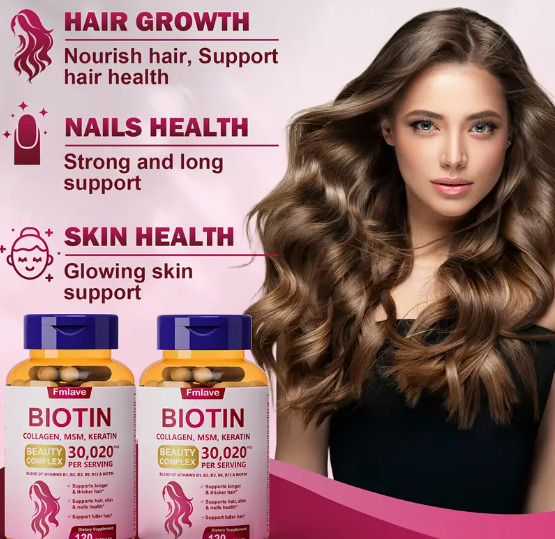
Niche Description: Beauty isn’t just skin-deep – that’s the idea behind beauty supplements, also known as nutricosmetics. These are vitamins, gummies, powders, or teas formulated to improve hair, skin, and nails from within. Think biotin gummies for hair growth, collagen powders for skin elasticity, detox teas for a clearer complexion, etc. This niche bridges beauty and wellness, tapping into the self-care trend where consumers take a holistic approach. The market is substantial and growing, as more people believe in a “beauty from within” approach and are repeat-buying consumables that promise aesthetic benefits. As a dropshipper, white labeling supplements is feasible through specialized suppliers who handle formulation, labeling, and compliance.
Popular Product Types: Hair and nail vitamins (often biotin-rich or containing a blend of vitamins A, C, E), collagen supplements (powder or capsules, sometimes plant-based collagen boosters), skin probiotics (for acne or gut-skin health), and multitasking wellness drinks (for example, a collagen + vitamin C drink mix). Also, detox teas or herbal blends marketed for skin clarity or anti-aging benefits fit here. The ever-popular “gummy vitamins” (like gummy bears for hair growth, made famous on social media) continue to be a hit, especially if they are sugar-free or use natural flavors.
Ideal Customer Profile: Primarily women aged 20-45, although a growing number of men also take these supplements (for hair growth or grooming). These customers are health and beauty conscious – they likely already use skincare topically and are adding supplements to enhance results. Many are repeat purchasers, since supplements are usually taken over months. They value convenience (e.g., tasty gummies over pills) and are often influenced by testimonials and before/after evidence (like someone showing improved hair thickness after 3 months of a supplement). Some may be skeptical, so building trust is key.
Dropshipping Tips:
-
Partner with Specialized Suppliers: Dietary supplements are regulated, so use trusted white label suppliers like Supliful, which specializes in US-made white label supplements and even offers label design and compliance support. These suppliers ensure products meet FDA guidelines and provide Certificates of Analysis or ingredient transparency, which you might need if customers ask. They often let you personalize the label design easily – a big plus for branding. Keep in mind shipping considerations (some supplements can only ship to certain countries due to regulations, but within the US you’re generally fine).
-
Branding & Trust: In supplements, your brand credibility is crucial. Design labels that look professional and clear. Include all required info (ingredients, suggested use, disclaimers) – your supplier will usually give you a template. It’s wise to have a page on your site about your “formula philosophy” or quality standards (e.g., “Made in USA, in an FDA-registered facility, GMP certified” if applicable, and statements like “Non-GMO, Gluten-Free” if true). These build trust. Even though it’s white label, treat it like your own high-end product line.
-
Marketing Strategy: Leverage the power of social proof. Encourage customers to document their journey (like before and after photos for hair or skin improvements) and share testimonials. Use influencer marketing carefully – look for beauty or wellness influencers who can genuinely try your product for a period and then promote it with results (expect to provide free product and possibly a fee, but the ROI can be strong if their audience trusts them). Content marketing ideas: blog about “Top 5 Vitamins for Glowing Skin” or “How Collagen Can Make You Look Younger” – naturally incorporating your products as solutions. SEO keywords like “hair growth supplements” or “best collagen for skin 2025” can drive organic traffic if you create content around them. One note on advertising: platforms have policies on supplement ads, so ensure any claims you make are mild and always true (no miracle cures, just benefits like “supports healthy hair”). Pricing-wise, supplements often have great margins – for example, costing you $7 and retailing for $30 – but be competitive and highlight how one bottle is a one-month supply (value justification). Finally, because these are consumables, consider a subscription model or bulk discount (buy 3 get 1 free) to increase the lifetime value of each customer.
15. Anti-Aging & Specialty Skin Treatments - White Label Beauty Dropshipping Products
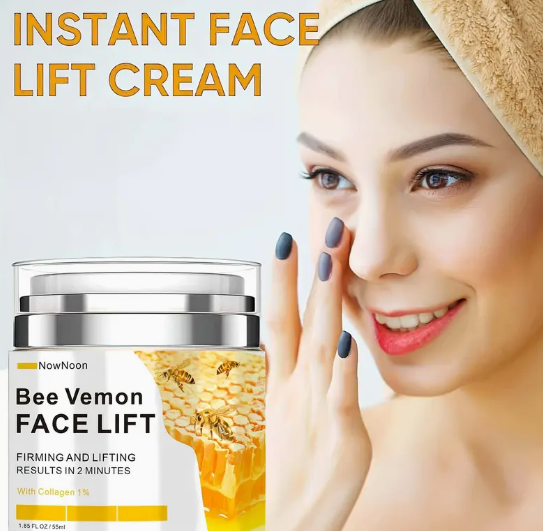
Niche Description: Anti-aging remains one of the most lucrative niches in beauty, as consumers are continually seeking products that reduce wrinkles, fine lines, and age spots. In fact, “anti-aging formulas” are highlighted as a key niche opportunity going into 2025. This niche includes high-performance skincare treatments like retinol creams, peptide serums, vitamin C treatments, and specialized masks or peels. It overlaps with skincare essentials but is distinct in targeting a specific concern (aging) and often a slightly older demographic. These products tend to command higher prices due to potent ingredients and promised results.
Popular Product Types: Retinol serums or creams (retinol is a gold-standard anti-aging ingredient), collagen-boosting creams, eye creams for crow’s feet, neck-firming creams, and concentrated Vitamin C serums for brightening dark spots. Also, newer trends include bakuchiol (a natural retinol alternative) products, and gadgets or kits like micro-needling derma rollers paired with growth-factor serums. Don’t forget sunscreen – while not a treatment per se, SPF products are often marketed under anti-aging as prevention is key. Some brands also have specialty items like sleep masks (overnight creams) or ampoules for intensive treatment.
Ideal Customer Profile: Primarily women (and some men) aged 30-60. Within this, two subgroups: those in their late 20s to 30s who are starting “preventative” anti-aging routines (often focusing on things like early fine lines, or just keeping skin youthful), and those 40+ who are addressing visible signs of aging (wrinkles, loss of firmness, age spots). These customers are usually willing to invest in quality products that deliver results – they might have used major brands before and are looking for effective alternatives. They pay attention to clinical ingredients (like retinol percentage, hyaluronic acid, etc.) and often do research or read reviews before buying.
Dropshipping Tips:
-
High-Quality Suppliers: For this niche, product efficacy is everything. Partner with suppliers that have a strong reputation or even offer private label cosmeceuticals. Some suppliers may specialize in small-batch, medical-grade formulations (sometimes you find them through networking or B2B marketplaces focusing on skincare). Ensure ingredients like retinol, peptides, etc., are present in effective concentrations. It might be worth choosing products that are made in regions known for skincare innovation (like the US, Canada, South Korea, or certain European countries) and highlight that in marketing.
-
Branding as Premium: Anti-aging products can be positioned as luxury or clinic-grade, which justifies higher pricing. Use upscale packaging – think airless pump bottles for serums (to preserve active ingredients) and metallic or dark-colored glass jars that suggest stability and luxury. A refined brand name and logo (perhaps incorporating words like “Labs,” “Derm,” or “Youth”) can create a trust factor. It’s also effective to have a clean, professional website design for this niche, with before-and-after images and possibly quotes from skincare professionals or stats (provided by your supplier or generic like “X% of users saw improvement in 4 weeks” if you have that data legitimately).
-
Education & Trust-Building: Anti-aging shoppers often need education on why your product works. Incorporate content about the science – for example, explain how retinol boosts cell turnover or how peptides signal collagen production. Use infographics or blog posts for this. If your supplier provides any clinical test results or white papers, summarize those. Also, ensure you have clear usage instructions and warnings (like “use sunscreen with this product” for retinols, etc.) – being transparent and responsible can set you apart as a credible brand. Encourage reviews from early customers, as peer validation is big in this segment (“I noticed my fine lines getting softer after 3 weeks!” type feedback). Market primarily on channels where slightly older demographics are present – Facebook Ads targeting, skincare forums, maybe even LinkedIn groups or Google Ads for keywords like “best anti-aging serum”. And don’t shy away from email marketing – send educational series like “How to build an anti-aging routine” to subscribers, featuring your products at each step. As for pricing, anti-aging products can have high profit margins – for instance, a serum that costs $8 to source could retail for $40-$60. Customers will pay if they believe in the results, so focus your marketing on the problem-solution aspect and the value (confidence, youthful appearance) your niche brand provides.
Final Thoughts: Launching a white label beauty brand in 2025 offers an exciting opportunity to capitalize on massive market trends while building your own unique brand identity. Whether you dive into skincare, makeup, haircare, or any of the niches above, success in the U.S. market will hinge on understanding your ideal customer, curating quality products from reliable suppliers, and crafting a brand story that resonates. Keep in mind the practical tips on sourcing (e.g., using platforms like CJdropshipping for custom branding support or niche suppliers for specialty items), and pay attention to branding and marketing – these are what differentiate your products from similar ones out there.
Remember, the beauty of white label dropshipping is agility. You can start lean, test what resonates with your audience, and expand your catalog or pivot niches as trends evolve. With consumers increasingly seeking personal, story-driven brands (and willing to buy online more than ever), now is an opportune time to carve out your space in the beauty world. Focus on delivering value, be it through effective ingredients, ethical values, or a community-building approach, and you’ll be well on your way to building a memorable beauty brand. Here’s to your success in the dynamic and rewarding beauty dropshipping arena!

